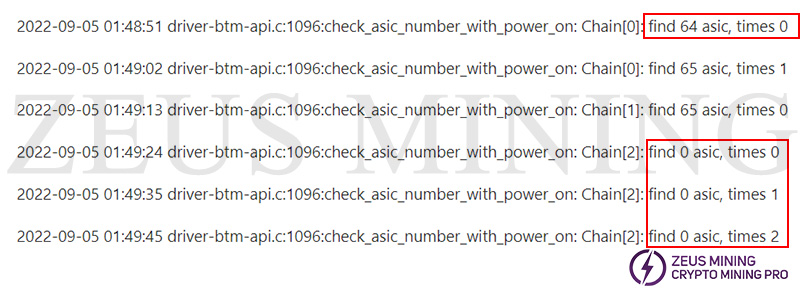


When the S17+ log shows that the No. 1 hash board found 64 asic, and the No.3 hash board found 0 asic (under normal circumstances, each hash board should find 65 asic). But the log finally shows STATUS_OKAY and ideal_hash_rate = 48976, indicating that there is no problem with the voltage and temperature sensors of the hash board, but the hash rate has decreased due to the failure of two hash boards. If the above failure occurs (as shown in the figure below), you can troubleshoot according to the following methods:


Solution:
1. Fixture test No.1 hash board. Then according to the test results, use the method of two-point short-circuit "CO", check in turn according to the transmission direction of the CO signal, find the chip with abnormal CO signal, and then check the voltage of the CLK, RET, CO, RI, BO signal of the chip, and finally according to the test results, replace the faulty one.
2. First, test the total domain voltage (normally around 21V). If the total domain voltage is abnormal, you need to check the output of PIC (normally around 3.3V), DC circuit output (normally around 21V), and boost output (normally around 24.5V). If the total domain voltage is normal, check the RI signal voltage of the ASIC chip (normally about 1.8V). We generally check from the back to the front according to the transmission direction of RI. After finding the abnormal RI voltage, test the domain voltage (normally about 1.6V), LDO1.8V, and PLL0.8V of the domain corresponding to this RI. If LDO1.8V and PLL0.8V are abnormal, then test whether they are short-circuited. If not, replace them directly to solve the problem. If LDO1.8V and PLL0.8V are normal, test whether the ASIC chip is short-circuited; if not, replace it directly to solve the problem.
Dear Customers,
Hello, April 4, 5 and 6, 2025 (GMT+8) are the traditional Chinese festivals - Qingming Festival. Our company will suspend shipments during these 3 days and resume shipments on April 7 (GMT+8). We are deeply sorry for the inconvenience. Thank you for your understanding and support.
Best wishes,
ZEUS MINING CO., LTD